Intel just released some more information on their new Thunderbolt 4 standard, so if you’re trying to tell the difference between Thunderbolt 3, Thunderbolt 4 and of course, USB4, then this article is for you.
The first thing to know about Thunderbolt 4 is that it uses the same exact port design as it has for years, so just by looking at the port, you won’t be able to tell between a regular USB-C port, a new USB4 port and a Thunderbolt 4 port, so you’ll have to rely on looking up the specs of the computer or laptop that you’re buying to know which port it actually is.
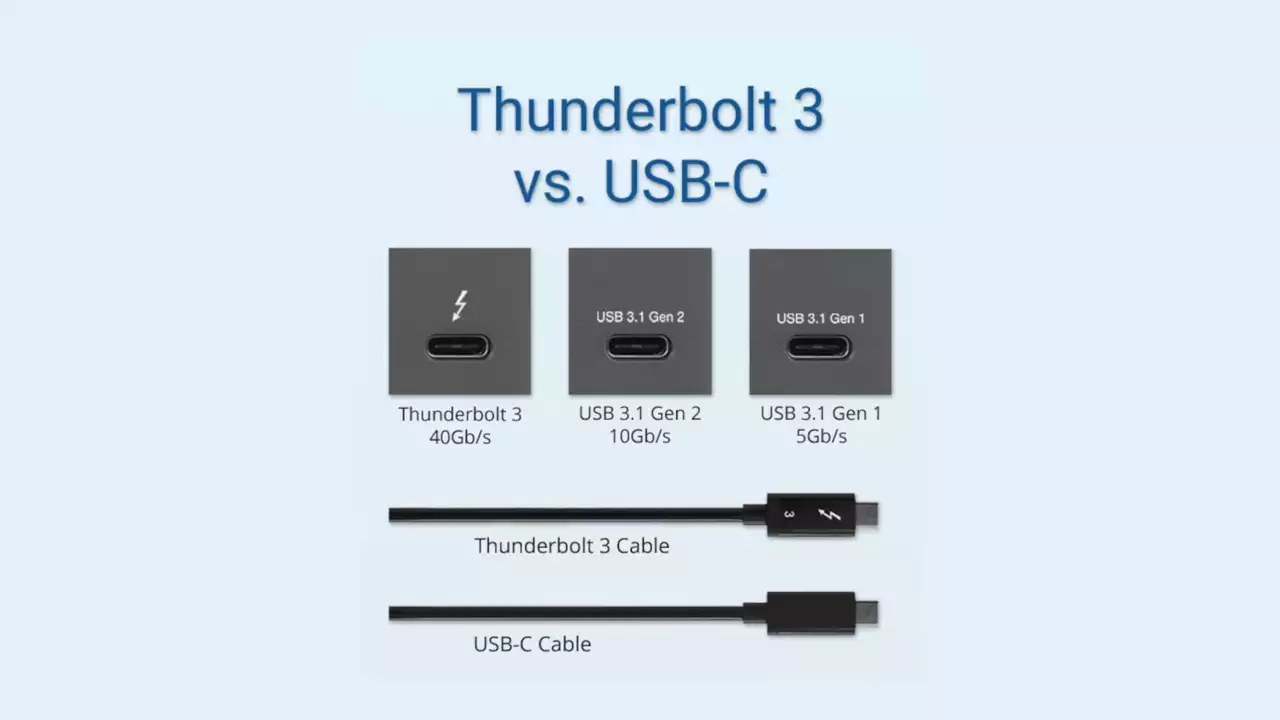 Before I get into the specs of Thunderbolt 4, let me first explain what USB-C is and how it compares to Thunderbolt 3.
Before I get into the specs of Thunderbolt 4, let me first explain what USB-C is and how it compares to Thunderbolt 3.
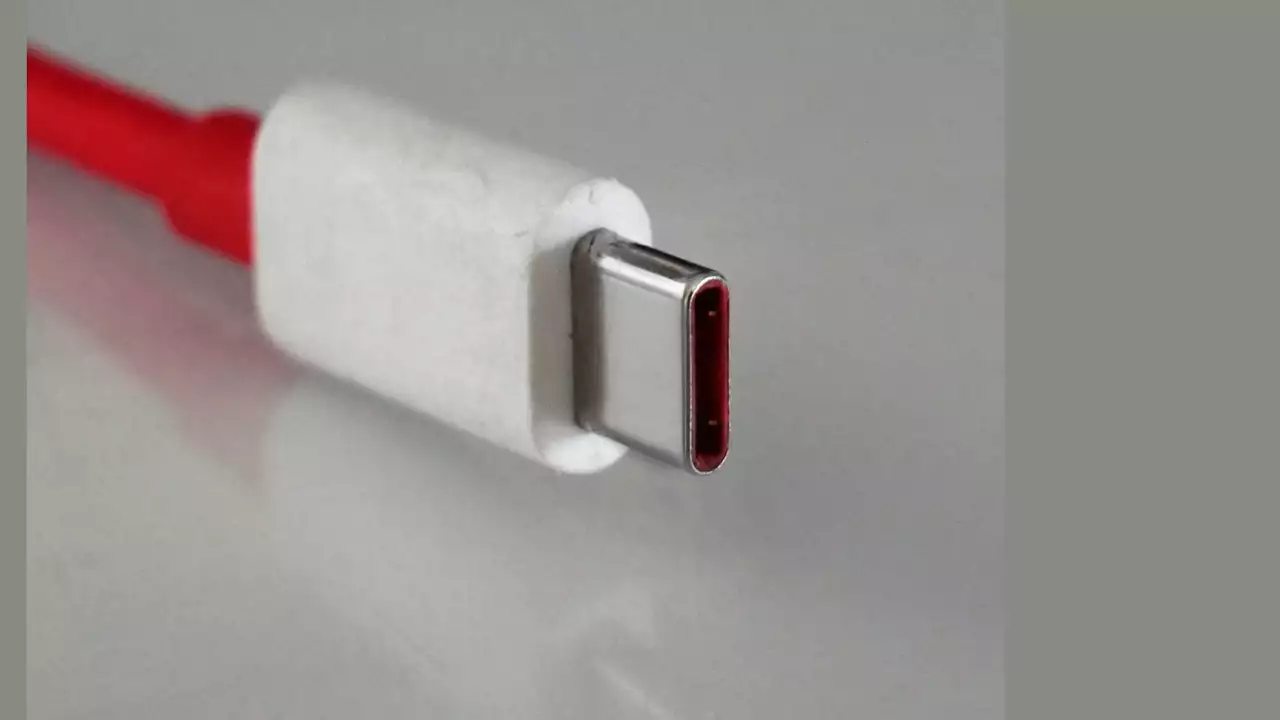 The USB Type C connector is basically the solution to the flawed design of the USB-A connector, which is known for being super annoying since you have to plug something in using the correct orientation. With USB-C, it doesn’t matter which way you plug it in since the connectors are in the center, so it works every time.
The USB Type C connector is basically the solution to the flawed design of the USB-A connector, which is known for being super annoying since you have to plug something in using the correct orientation. With USB-C, it doesn’t matter which way you plug it in since the connectors are in the center, so it works every time.
Digging deeper into USB-C, there are actually different transfer speeds that are supported with really confusing names that were recently updated for the second time, and ironically, they’re still confusing.  There’s USB 3.2 Gen 1 which supports a maximum speed of 5Gbps, there’s 3.2 Gen 2 which goes up to 10Gbps, and there’s 3.2 Gen 2x2, which goes up to 20Gbps. And the only way to know the difference is to check the specs of your computer.
There’s USB 3.2 Gen 1 which supports a maximum speed of 5Gbps, there’s 3.2 Gen 2 which goes up to 10Gbps, and there’s 3.2 Gen 2x2, which goes up to 20Gbps. And the only way to know the difference is to check the specs of your computer.
But the great thing about USB Type C is that it allows up to 100W of power to be transferred from one device to another, compared to only 7.5W of power using the square USB Type A connector. That’s the reason why Apple’s 18W Fast-Charging brick uses USB-C.
This is where Thunderbolt 3 comes in. It uses the same Type-C connector and it supports USB-C devices, but it also supports speeds of up to 40Gbps. Not only that, but it’s made to support more protocols, like DisplayPort 1.2 by using an adapter and PCI Express for handling data transfer between computers and things like eGPUs. And because of its high 40Gbps bandwidth, it’s able to power high resolution displays like two 4K displays, a single 5K display, or even Apple’s 6K Pro Display XDR by using a new version of Display Stream Compression that squeezes all of those pixels into a less than 40Gbps stream. 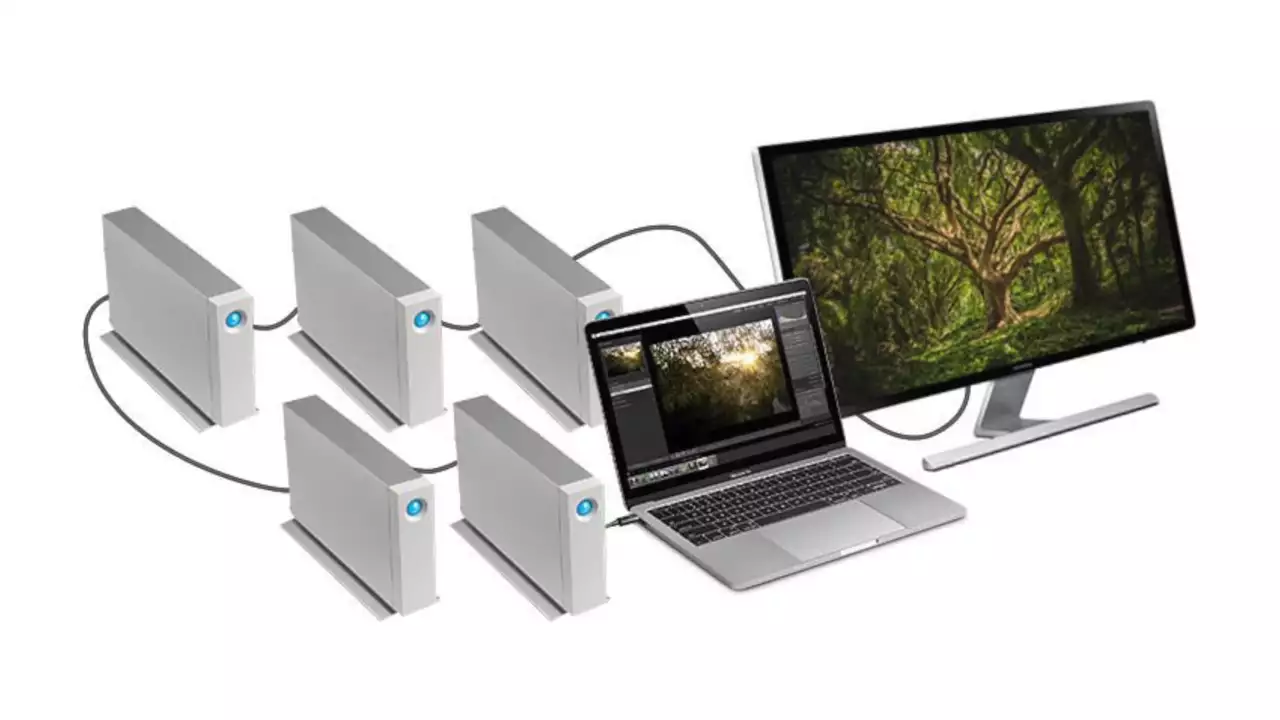 And it can even be used to daisy chain multiple monitors or devices together and ultimately end up with just one cable being plugged into your computer. But keep in mind that there are some Thunderbolt 3 cables that only support 20Gbps speeds, so it’s very important to buy the right cable if you want the full 40Gbps speed.
And it can even be used to daisy chain multiple monitors or devices together and ultimately end up with just one cable being plugged into your computer. But keep in mind that there are some Thunderbolt 3 cables that only support 20Gbps speeds, so it’s very important to buy the right cable if you want the full 40Gbps speed.
But the important thing to know about Thunderbolt 3 is that it almost always requires an Intel-made ThunderBolt 3 Controller chip inside of the computer or laptop to support it. So every time you see a laptop with Thunderbolt 3 ports, they had to buy that chip from Intel and integrate it into their laptop. Broll of port on silver laptop And on the other side, a device like an SSD that supports Thunderbolt 3 also needs a controller chip certified by Intel, which obviously isn’t free, so that’s why you don’t see very many Thunderbolt 3 devices, at least not cheap ones. And those thunderbolts 3 controller chips that I mentioned can support up to two full-speed Thunderbolt 3 ports.
So for example, with Apple’s 16” MacBook Pro, which has four Thunderbolt 3 ports, it actually uses two separate Intel controller chips to support them. However, with Intel’s newest mobile Ice Lake processors, they’re finally integrating Thunderbolt 3 into the processor itself, no longer requiring an external Thunderbolt 3 Controller chip.
And now with all of that out of the way, we can move onto USB4 before we finish with Thunderbolt 4.
On March 4th of 2019, Intel released the Thunderbolt 3 specification, finally making it royalty-free, to be used to form USB4, which uses the same Type-C connector, except that it no longer requires an Intel Thunderbolt controller or Intel certification. This means that we should see USB4 ports coming to basically every computer and laptop very soon. But the beauty of USB4 is that it supports the same 40Gbps speed as Thunderbolt 3, so you could potentially use a USB4 port in the future to connect a 6K display.
To make it even better, USB4 can support everything that Thunderbolt 3 supports, including DisplayPort and even PCI Express Tunneling to use with an eGPU. And this all happens without requiring an Intel Thunderbolt controller or Intel certification, meaning that eGPUs and high-speed devices are going to become cheaper and more widely available than ever before.
But another important detail to know is that not all USB4 ports and cables will be the same, since Intel is only requiring USB4 cables to support a single 4K display, a minimum of 10Gbps speed and only 7.5W of power delivery, so be sure to buy the correct cable. But basically, USB4 is the dream. You get support for very high 40Gbps data transfer speeds and support for DisplayPort and PCI Express connections, but while being completely royalty-free and no longer requiring an Intel controller chip.
Let’s finally move onto Thunderbolt 4, and the most surprising thing is that the maximum speed stays the same at up to 40Gbps, but it still requires a Thunderbolt 4 controller chip and Intel certification, so it doesn’t seem like a very great deal. But it seems like most of the changes are oriented towards quality control, so let’s take a look at a handy chart created by Intel.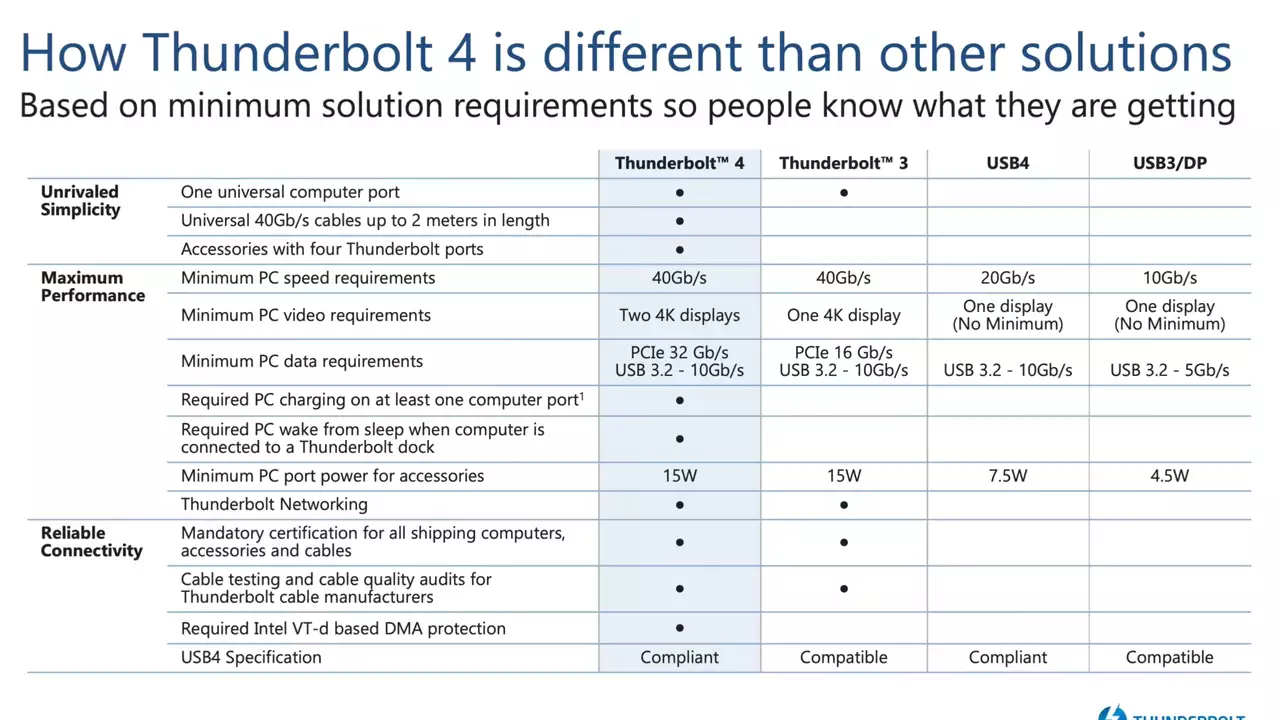
Starting from the top, Intel is requiring Thunderbolt 4 cables to support the full 40 GB/s speeds, so you don’t have to worry about buying the wrong cable anymore. Thunderbolt 4 accessories like docks can now have up to four ports instead of the previous two. Intel is also now requiring Thunderbolt 4 cables to support two 4K displays or one 8K display, support power delivery charging, support wake from sleep when using a Thunderbolt dock, support Intel VT-D DMA protection, and support full PCI express 32Gbps transfer speeds. And that’s basically it, the only real new feature is getting four Thunderbolt ports on a dock instead of two.
Other than that, Intel is simply requiring every Thunderbolt 4 cable and device to support a higher standard of speeds and display support, so you won’t get screwed by buying a cheap cable.
Intel announced that their Tiger Lake line of CPUs will soon be the first to integrate Thunderbolt 4, and therefore not requiring a controller chip. And to be completely honest, all of those changes don’t really matter to me or regular consumers like me, and I’m finding it hard to believe that manufacturers are going to jump to support Thunderbolt 4 since the minimum requirements went up, making cables more expensive to produce.
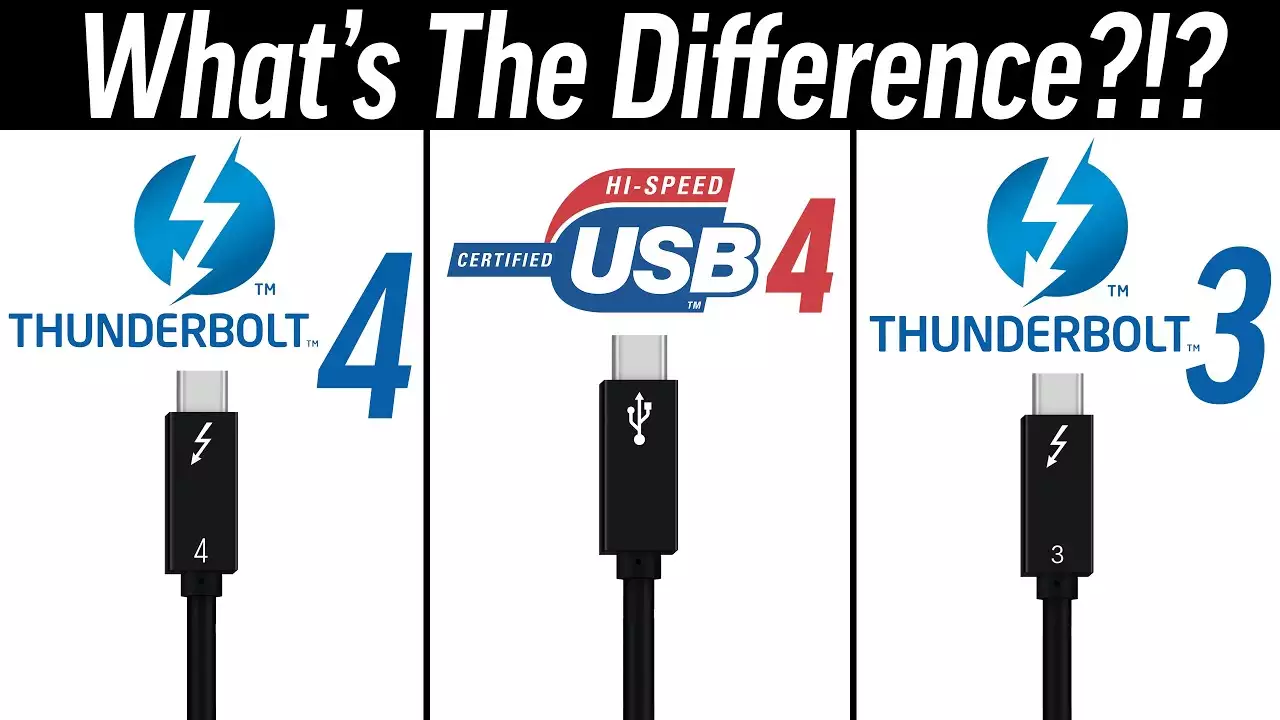

No comments yet